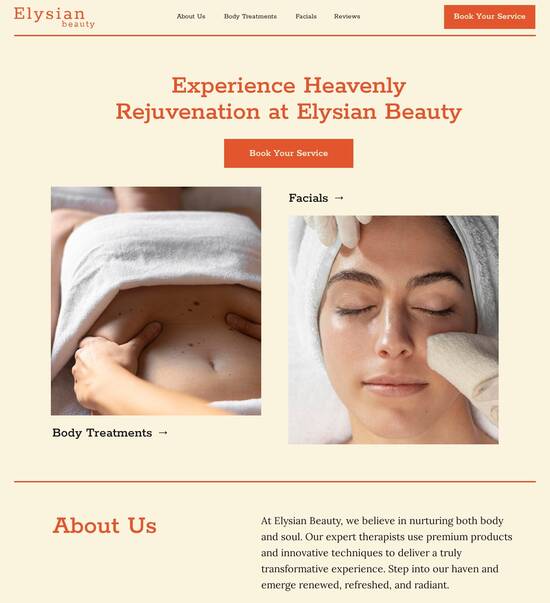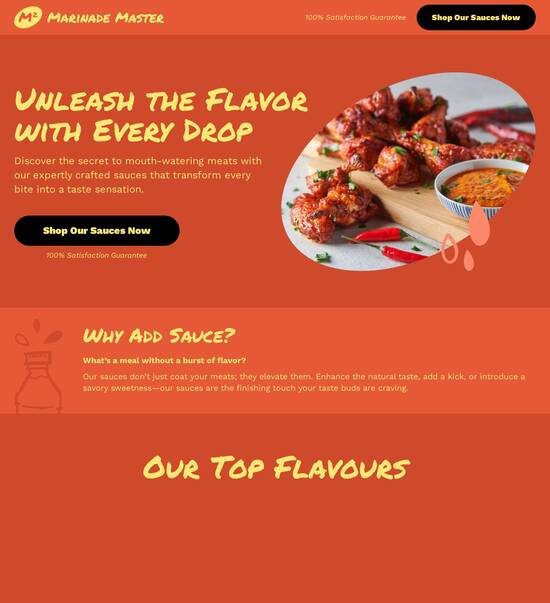
Animated 403 forbidden page template
Explore Similar TemplatesAbout template
Unleash your creativity with the animated 403 forbidden page template. Try Instapage today.
Recommended templates

Easy to build without coding
With the intuitive drag-and-drop builder, anyone on your team can create high-converting pages without any knowledge of code or design. Make enhancements to your landing page with custom widgets using Javascript, HTML/CSS, or third-party scripts.

Multiple layouts for any industry and goal
Select from 500+ landing page layouts built to boost conversions across industry-specific scenarios. Customize them by adjusting fonts, adding images, and generating on-brand content with the AI assistant. Quickly scale with Instablocks® and Global Blocks that you can save, reuse, and update globally.

Loads fast and looks polished on any device
Every template is responsive, which means they present professionally on any device and load blazingly fast with our Thor Render Engine. You can also power them up with Google AMP technology to deliver an unparalleled mobile experience and drive higher conversions.

Robust analytics & experimentation
Get real-time updates and reporting across all your devices, showing the number of visitors, conversions, cost-per-visitor, and cost-per-lead. Launch AI-powered experiments, run A/B tests, and use heatmaps to analyze user behavior, then optimize your landing page to maximize conversions.







Easy to build without coding
With the intuitive drag-and-drop builder, anyone on your team can create high-converting pages without any knowledge of code or design. Make enhancements to your landing page with custom widgets using Javascript, HTML/CSS, or third-party scripts.
Multiple layouts for any industry and goal
Select from 500+ landing page layouts built to boost conversions across industry-specific scenarios. Customize them by adjusting fonts, adding images, and generating on-brand content with the AI assistant. Quickly scale with Instablocks® and Global Blocks that you can save, reuse, and update globally.
Loads fast and looks polished on any device
Every template is responsive, which means they present professionally on any device and load blazingly fast with our Thor Render Engine.
Robust analytics & experimentation
Get real-time updates and reporting across all your devices, showing the number of visitors, conversions, cost-per-visitor, and cost-per-lead. Launch AI-powered experiments, run A/B tests, and use heatmaps to analyze user behavior, then optimize your landing page to maximize conversions.
All the features you need to build access denied page template html code
Explore more featuresLearn how to build 403 forbidden page design
Frequently asked questions about 403 forbidden template
Leading the way in building high-performing landing pages





403 page template: Your ultimate how-to guide
In the fast-paced world of online marketing, having the right tools can make or break your campaigns. Instapage's landing page and conversion rate optimization (CRO) platform empowers marketers to create compelling landing pages quickly and efficiently, catering specifically to your business needs. By harnessing the potential of high-converting templates and sophisticated optimization techniques, you can significantly enhance your return on investment (ROI).
Understanding Instapage's innovative landing page features
Instapage offers a robust set of features that streamline the landing page creation process, making it accessible for both large and small marketing teams. Whether you are part of a financial service provider or an educational institution, Instapage provides tools that facilitate the creation of tailored pages designed to convert visitors into leads.
- Ready-to-use templates: Choose from over 100 high-converting templates to jumpstart your campaigns.
- Drag-and-drop builder: Use the intuitive interface to customize your landing pages without needing coding skills.
- Integrations: Seamlessly connect with various marketing tools and platforms to enhance your campaigns.
Step 1: Build your landing pages with ease
Creating a captivating landing page on Instapage is straightforward. Follow these simple steps to leverage Instapage's powerful features:
- Select a template that aligns with your campaign goals and adjust it to reflect your brand identity.
- Utilize Instablocks to insert pre-designed elements like headers, footers, and FAQs, allowing for rapid page assembly.
- Preview your page to ensure it resonates with your target audience's expectations.
Step 2: Optimize for conversions
Optimization is crucial for successful marketing campaigns. Instapage provides built-in tools to enhance your page’s performance:
- A/B testing: Experiment with different headlines, images, and calls to action to see which versions perform best.
- Heatmaps: Analyze user interaction on your pages to spot engagement trends and areas for improvement.
- Analytics dashboard: Measure your landing page effectiveness and conversion statistics in real time.
Step 3: Personalize your visitor experiences
Tailoring your content to meet the expectations of distinct audience segments can greatly increase your conversion rates. Here's how to do it:
- Dynamic text replacement: Adapt your landing page content based on the referring source so that it speaks directly to the visitor's interests.
- AdMaps: Tailor specific ad campaigns to unique landing pages to ensure seamless user experiences.
- Audience tracking: Use data tools to gain insights into how different demographics are interacting with your content.
Utilizing Instapage for your landing pages allows you to harness the full potential of your digital marketing strategies, ensuring higher engagement and conversion rates.
Ready to transform your marketing efforts? Start using Instapage today and experience the power of optimized landing pages.
The ultimate guide to creating an animated 403 forbidden page template
Understanding the essence of an animated 403 forbidden page
Every website will eventually encounter errors, and understanding how to navigate these instances, especially a 403 forbidden error, is crucial for user experience. An animated 403 forbidden page serves not just as a means of communicating the error but also as an opportunity to convey a brand’s personality. It’s about creating a user-friendly interface that minimizes frustration, clarifies the issue, and guides users to next steps.
The importance of error pages in user experience
Error pages, particularly the 403 forbidden page, play a vital role in user engagement. They act as unexpected junctions in the user’s journey, and how a brand addresses these moments can differentiate it from competitors. A study revealed that nearly 60% of users typically abandon a website after encountering an error page, highlighting the need for error messaging that effectively communicates the issue while keeping users engaged.
Moreover, first impressions matter immensely. A poorly designed 403 forbidden page hurts visitor retention, while a well-crafted page can soften the blow of an error. Leveraging animation on a 403 forbidden page can enhance the overall impression by merging functionality with creativity, keeping users interested and guiding them to continue their exploration.
What is a 403 forbidden page?
A 403 forbidden error is a status code indicating that the server understands the request but refuses to authorize it. Typically, this occurs due to permissions issues, such as user access rights not being granted, or the server being misconfigured to deny access to the requested page. As a result, users are often left frustrated when they encounter this type of error.
User expectations can sharply contrast the reality of encountering a 403 error. For most, a website represents a gateway to information or services, and being met with a forbidden message disrupts their journey, leading to confusion and possible abandonment. Thus, providing clarity through an animated, visually appealing error page can help manage user emotions and offer guidance on how to proceed.
The power of animation in error pages
Animation in error pages isn’t just a visual treat; it’s a strategic choice that enhances user engagement. Well-crafted animations capture user attention and create a memorable experience. Behavioral studies suggest that animated content evokes emotional responses, which can mitigate frustration associated with errors. Instead of feeling defeated by encountering a 403 forbidden page, users can find a moment of levity, prompting them to rethink their next steps.
There are various types of animations suitable for error pages. Subtle animations that guide users, such as pulsing buttons or loading icons, can render an otherwise stagnant error message more lively. Conversely, full-screen animations can enthrall users, though they must be balanced to avoid overwhelming. Inline animations can provide context without diverting attention, maintaining a seamless user experience.
Crafting a unique 403 forbidden page template
When designing an animated 403 forbidden page, several key elements must be incorporated. Visual hierarchy is essential; ensuring that the primary message is readily visible while secondary information complements it without overshadowing. Clear and concise communication of the error's nature reassures users that their concerns are recognized while guiding them toward a solution.
Color palette also plays a critical role in user sentiment. A palette that balances inviting hues with a slight tone of seriousness can help convey the message without exacerbating frustrations. For instance, employing softer colors with white space creates an inviting ambiance, which discourages user abandonment. Integrating visual assets, such as effective GIFs or illustrations, can reinforce the page's message — making it less intimidating and more user-friendly.
Personalization: making users feel valued
Personalizing a 403 forbidden page can significantly impact a user's experience. Techniques like incorporating their username or geolocation into the message bring a human touch to the interaction, making them feel acknowledged rather than dismissed. This personalization fosters a connection, which can alleviate the disappointment of hitting a roadblock.
In addition, involving creative teams during the design process enhances the quality of the page. Collaboration between designers, marketers, and UX specialists can lead to innovative ideas that present clear error messaging while embodying brand identity. Many successful brands actively seek diverse perspectives in their design collaboration, enabling them to create visually stunning and effective error pages.
Technical considerations for implementing animation
When creating animated error pages, several best practices should be adhered to for optimal performance. For instance, ensuring quick loading times is vital; users are unlikely to wait around for a long-loading error page. Lightweight animations that transition smoothly can provide an engaging experience without sacrificing speed.
Additionally, accessibility considerations should be prioritized. Animations should be designed to be inclusive, ensuring that visually impaired users can still understand the message conveyed. This can be achieved through appropriate alternative text and maintaining color contrast standards. For those without coding expertise, there are numerous design tools available that simplify the integration of animations into pre-existing websites without complex programming knowledge.
Testing and optimization of animated 403 forbidden pages
User feedback is invaluable for refining a 403 forbidden page. Implementing feedback collection techniques, like surveys or exit rate analytics, aids in understanding user reactions and expectations. Analysis of this data can lead to iterative designs that continuously improve user satisfaction and might even reduce bounce rates following errors.
Moreover, A/B testing animated elements provides actionable insights into what resonates with users. By experimenting with variations such as text messaging, colors, and animation styles, designers can discover which formats yield the highest engagement rates. Metrics for tracking success include user retention post-error, average time spent on the page, and interactions with suggested actions.
Case studies: successful implementations of animated 403 pages
Several brands have notably excelled at presenting creative animated 403 forbidden pages. For instance, a popular tech brand employed an animated robot offering a humorous explanation of the error, which helped humanize the disconnect and entertained users while redirecting them to the homepage. Such innovative approaches have successfully kept users on the site, showcasing the positive impact of well-thought-out error messages on brand perception.
Conversely, many brand failures stem from poor designs that alienate users. Common pitfalls include overly complex animations that confuse rather than inform and lack of guidance for next steps. These missteps lead to increased bounce rates and negative sentiment towards a brand. Understanding the rationale behind successful designs and recognizing these pitfalls aids brands in crafting error pages that enhance user experience.
Future trends in error page design
Looking ahead, the evolution of animated error pages will likely be influenced by emerging technologies like AI and machine learning. These advancements could enable more refined user personalization, tailoring error messages and animated designs based on individual user behavior and preferences. As a result, error pages may become far more interactive, mimicking the dynamic nature of a conversation rather than a static messaging window.
Simultaneously, user expectations continue to shift. Today’s users demand seamless, engaging online experiences; as online norms evolve, so too will the standards for error handling. Understanding these changes enables brands to adapt their approaches, ensuring that even when mistakes happen, users feel valued and remain connected.
Key takeaways for designing your animated 403 forbidden page
To successfully implement an animated 403 forbidden page, start by developing a clear outline of your messaging. Consider essential elements, such as visual hierarchy, color palette, and user personalization. Integrate subtle animations that encourage user engagement, not distraction, and include responsive design elements for mobile optimization.
Lastly, it’s crucial to test and iterate based on user feedback, refining the design to meet evolving user needs. Remember, every error presents an opportunity to engage users positively, turning a frustrating moment into a memorable experience. With thoughtful design, an animated 403 forbidden page can leave a lasting impression on users.
Ready to skyrocket conversions?
Supercharge your ad campaigns with high-performing landing pages
Get started














